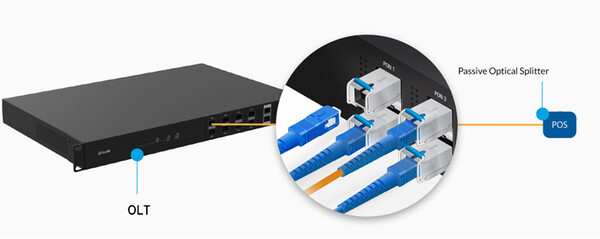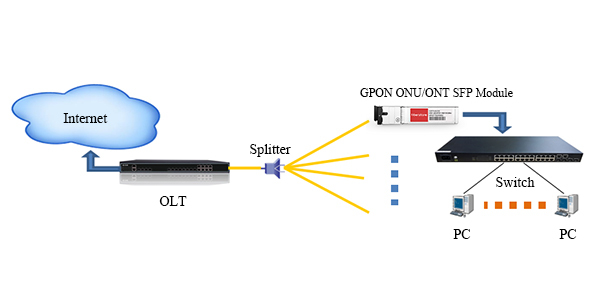-
Since the advances in Ethernet technology, “last mile” connectivity is expected to realize between the network backbone and local area networks (end users). Gigabit Passive Optical Network (GPON) is a cost-effective point-to-multipoint access network, which brings great improvement in data transmission distance (up to 20km) and bandwidth (an downstream capacity of 2.5Gbit/s and an upstream capacity of 1.25Gbit/s ). However, GPON's higher bandwidth and split ratios are only achievable by using GPON-capable optical transceivers. It is well positioned to help meet the needs for higher bandwidth in FTTx applications, and continues to fuel growth in demand for GPON SFP modules. So this article will introduce the basics of GPON SFP, including GPON OLT, GPON ONU and GPON ONT SFP module.

What Is GPON SFP Module?
GPON SFP is a new higher-speed bi-directional optical transceiver, which can deliver 2.5 Gbits/sec of bandwidth. And it is a kind of single fiber transceiver which comes with SC connector and can transmit data up to 20km. In addition, it features a 28-dB optical loss budget to enable 1:64 split ratios and provides adequate optical loop lengths. Most EPON and some BPON systems deployed today use 25-dB optics, which limit the split ratio and loop length. For this reason, GPON transceiver enjoys the added advantage of industrial demand. The key performance advantage is to reduce the upstream split loss arising from utilizing the mode-coupled-receivers (MCR) in a PON application. Moreover, this innovative module dose not outweigh the costs over a standard module. For these two reasons, the GPON SFP modules are very attractive to the network operators to improve the utilization of GPON network. On top of that, GPON SFP transceiver is an essential part of GPON system which is necessary both for optical network unit (ONU) installed at the subscriber’s premises and for the optical line terminal (OLT) at the central office (CO). The following part will respectively introduce the GPON OLT, GPON ONU and GPON ONT SFP module.

GPON OLT SFP Module
GPON OLT SFP is designed for OLT side in GPON network. OLT is a equipment integrating L2/L3 switch function, which is located in central office (CO). The main function is to control the information float in both directions: upstream and downstream. The GPON OLT module plays an inevitable role in the upstream and downstream transmission. In order to put across the transmission process, the downstream transmission is taken as an example. A single mode optical fiber coming from OLT (at the central office) PON port, runs to the passive optical splitter (POS) located near end users. And then the optical splitter will divide signals into separate paths which can provide service up to 64 end users. In this basic GPON topology, a GPON OLT module is used to connect a single-mode fiber patch cable to a passive optical splitter. Therefore, GPON OLT transceiver works to get the data, voice and video traffic from metro network or from a long-haul network.

GPON ONU/ONT SFP Module
Since the ONU and ONT are deployed at customer’s premises, they are connected to the OLT by means of optical fiber and no active elements are present in the link. In GPON network, the ONU/ONT transceiver is the physical connection between the customer premises and the central office OLT. This type of modules gets the signals from OLT, so they have the opposite characteristic of GPON OLT transceiver, incorporating a high performance 1310nm burst mode DFB transmitter and 1490nm CW mode APD receiver. By being plugged into advanced “triple play” (data, voice & video) ONT or ONU equipment (with SFP ports), such as Ethernet switches, routers, DSLAMs or home gateway, ONU/ONT SFP module fits seamlessly into existing communications equipment and provides end users with a smooth upgrade to GPON. Therefore, GPON ONU/ONT SFP module plays an important role in the applications for point-to-multipoint (P2MP) ONT / ONU equipment in GPON network.

Conclusion
GPON SFP transceiver meets the the requirements of FTTx network to accelerate the speed or capacity. GPON OLT, ONU and ONT SFP module have their respective roles to play in the GPON networks. Many people may worry the high attenuation losses from optical splitter in the GPON networks, as above mentioned, the GPON optical module is just used to solve this problem in that it utilizes the MCR technology that protects large numbers of signals. In a word, this new module is a compelling network alternative to save cost and increase bandwidth and security.
Related Article: ABC of PON: Understanding OLT, ONU, ONT and ODN
 votre commentaire
votre commentaire
-
With the increasing demands for higher capacity, more diversity and more personalization of services, the capacity and versatility of access networks needs to be expanded. Passive optical network (PON), as a major technology of FTTH, offers point-to-multipoint (P2MP) network access with lower installation and maintenance costs. EPON (Ethernet PON) and GPON (Gigabit PON) are popular versions of PONs at present. The related technologies keep developing and meanwhile the market of PON components keep growing. PON transceiver (EPON SFP or GPON SFP) is an essential part of PON system, in which a single fiber from a central office optical network unit (ONU) is connected to optical network terminals (ONTs) or optical network units (ONUs) at costomer premises. EPON SFP vs. GPON SFP is today’s main subject matter of this paper.

Passive Optical Network (PON)
Passive optical network (PON) is a form of fiber-optic access network. As the leading technology being used in FTTx (FTTH) deployments, so it is also called FTTH (fiber to the home) network. The typical PON arrangement is a point to multi-point (P2MP) network where a central optical line terminal (OLT) at the service provider’s facility distributes TV or Internet service to as many as 16 to 128 customers per fiber line. A PON reduces the amount of fiber and central office equipment required compared with point-to-point architectures. PON only uses fiber and passive components, thus it costs significantly less than those using active components. However, a PON has a shorter range of coverage limited by signal strength, which is typically limited to fiber cable runs of up to 20 km (12 miles). There are two different solutions developed by the IEEE and ITU-T - EPON and GPON. The main differences between them lie in the protocols used for upstream and downstream communications. The following table shows the detailed information about EPON vs. GPON.

Table 1: EPON vs. GPON
What Is PON Transceiver?
PON transceiver is a bi-directional optical transceiver that uses different wavelengths to transmit and receive signals between the OLT at the CO and the ONUs at the end users’ premises over a single fiber. According to the pluged-in device, PON transceiver can be divided into OLT transceiver module and ONU transceiver module with SFF, SFP/SFP+ or XFP package. Here mainly introduce two common OLT transceivers used in GPON or EPON network: GPON SFP and EPON SFP.

GPON SFP
GPON SFP OLT transceiver is designed for OLT side in GPON network. GPON SFP uses 1490nm continuous-mode transmitter and 1310nm burst-mode receiver. The transmitter section uses a 1490nm DFB (Distributed Feed Back) LD with automatic power control (APC) function and temperature compensation circuitry to ensure stable extinction ratio overall operating temperature range. And it is Class I laser compliant IEC825 and CDRH standards. The receiver has a hermetically packaged burst-mode APD-TIA (trans-impedance amplifier) pre-amplifier and a burst-mode limiting amplifier with LVPECL compatible differential outputs. The GPON OLT SFP transceiver is a high performance and cost-effective module for serial optical data communication applications to 2.5Gpbs. For GPON transceivers, there are 2 Class available - Class B+ and Class C+. The table below shows the key differences between GPON SFP class B+ and class C+:

Table 2: GPON SFP class B+ vs. GPON SFP class C+
EPON SFP
EPON SFP transceiver is the family of high performance optical modules providing a symmetric 1.25 Gb/s downstream and 1.25 Gb/s upstream data link over a single fiber using a 1490 nm continuous-mode transmitter and 1310 nm burst-mode receiver. The transmitter section uses a 1490nm DFB laser for superior performance and is Class 1 laser compliant. The receiver section uses a 1310nm APD, pre-amplifier, and limiting post-amplifier. The receiver does not require a reset pulse between incoming optical packets of varying signal strength. EPON SFP OLT transceivers support 1000BASE-PX20-D for 20 km applications.
EPON SFP VS. GPON SFP
In terms of OLT module, there are many similarities through EPON SFP?vs. GPON SFP, such as type of laser, transmission distance and communication model. The key difference among them is the sending power and receiver sensitivity. The sending power of GPON SFP Class B+ is 1.5~5dBm, and its receiver sensitivity is -28dBm while the sending power of Class C+ is 3~7dBm and receiver sensitivity is -32dBm. The sending power of EPON SFP is 2~7dBm and its receiver sensitivity is -28dBm. For GPON SFP, the upstream bandwidth is scalable from 155Mbps to 2.5Gbps while the downstream is designed to deliver 1.25Gbps or 2.5Gbps. It is the most widely used consumer broadband service in FTTH networks of present times. On the other hand, EPON SFP supports symmetric bandwidth of 1.25Gbps in both the upstream and downstream directions.

Table 3: EPON SFP vs. GPON SFP
Conclusion
Through EPON SFP VS. GPON SFP, we can see that they are the same in architecture but for different data rate and applications. In terms of cost, The GPON SFP optical module is more expensive than EPON SFP. Because the GPON chipsets available in the market are mostly based on FPGA (Field Programmable Gate Array), which is more expensive than the EPON MAC (Media Access Control) layer ASIC. When GPON reaches deployment stage, the estimated cost of a GPON OLT is 1.5 to 2 times higher than an EPON OLT. For the users who have demands of multi-service, high QoS and security, as well as ATM backbone network, GPON SFP seems to be an ideal. And for the one who is much care about the cost and has less security requirements, EPON SFP may be better.
Related Article: Passive Optical Network Tutorial
 votre commentaire
votre commentaire Suivre le flux RSS des articles
Suivre le flux RSS des articles Suivre le flux RSS des commentaires
Suivre le flux RSS des commentaires
